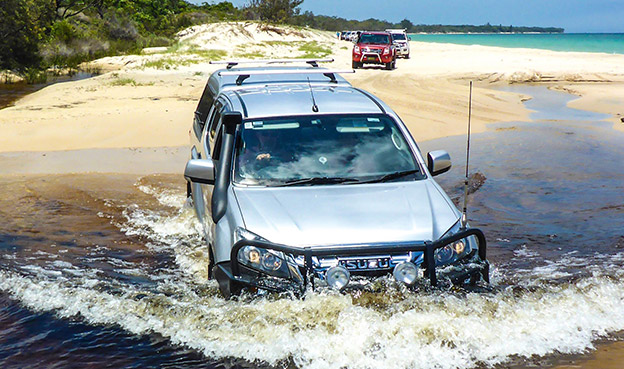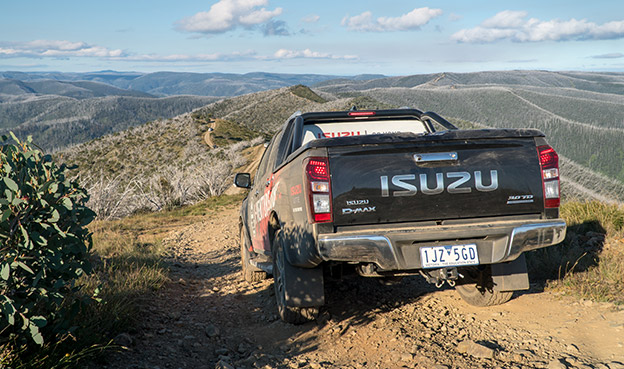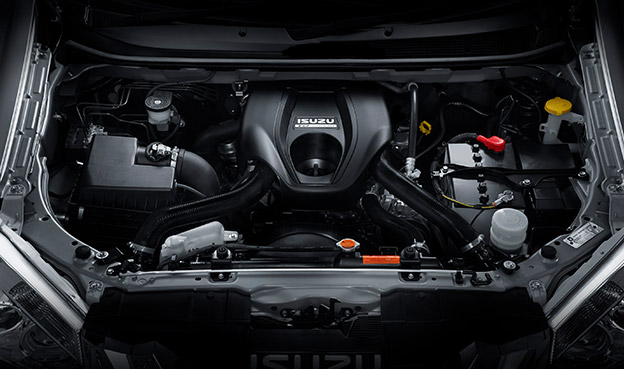

If you're a serious 4WD enthusiast you'll have been stuck at some stage. If you haven't, then your off-road adventures haven't been serious enough. So in the interests of those of you keen to push the envelope, over the next two issues we'll help you handle the worst aspects of getting stuck. First up: how to help yourself. Let's start at the bottom...
TYRE PRESSURE
If you've already been to one of our I-Venture Club days you will have heard me mention the importance of tyre pressure. It is THE number-one trick up your sleeve for staying mobile, yet so many people are unaware of its benefits.
The tyre pressure you should be running on-road (that's the blacktop) is stated on your tyre placard. Nearly every 4WD owner I come across off-road has their tyres overinflated, often by 50 per cent or more. Right from the get-go you're setting yourself up for a fail. An over-inflated tyre spells trouble!
An unladen D‑MAX or MU‑X should be running around 30PSI (200kPa) front and rear. As the track worsens, start letting air out. If you're struggling, let some more out. Each incremental adjustment of a few PSI will bring an immediate improvement.
If the trail is really bad, drop straight to 15PSI (100kPa) so the tyre's footprint length will stretch long and give you the flotation you crave.
If you avoid sharp turns, hard braking or acceleration, you should be able to keep that tyre on the rim. However, emergencies often call for drastic and quick solutions so 12PSI, 10PSI or maybe even 8PSI aren't unreasonable if your new Isuzu is in peril.

TRANSMISSION SELECTION
As soon as you move from bitumen to dirt, switch into high-range 4WD. Highspeed dirt kills plenty of holidaymakers and all the safety technology in the world can't overcome the laws of physics if you've hooked into that corner too fast, on gravel, in 2WD.
Just as we incrementally changed the pressure, you also need to adjust your speed downwards and be ready to select LOW range. Lots of folks only engage LOW when they are bogged–too late. The advantage with LOW range is torque and lots of it.
Whether auto or manual, you've got four or five forward gears at your disposal with a ground speed between zero and around 60km/h. This is plenty fast enough for most rough trails, but the difference between HIGH and LOW will be the amount of torque you'll have ready to punch through that next sand drift or lump of mud. In LOW you'll always have gears up your sleeve. Once the problem is dealt with you might be able to resume in HIGH.
LOSE THE TRACTION CONTROL
Traction control can be another hindrance. That button behind the indicator stalk turns off some of the safety electronics. On-road they're invaluable, doing a brilliant job of saving lives at high speeds. Off-road, however, traction control can get in the way.
Push and hold the button for a few seconds and you'll see the TCS symbol light up, confirming it's been disabled. Now, with no inhibitions you can squeeze gently on that accelerator pedal and get the desired effect.
STAY ON THE BALL. PLAN YOUR ATTACK –THEN REASSESS AS YOU GO
Let's say you're ascending a hill and you realise you've made a poor gear or range choice. Persisting with the forward motion might get you bogged. Think about the gradient and use it to your advantage by backing up. If you can find a better place to launch from, with a better gear combo, you might just be able to get through.
Use that same philosophy on a beach. If you're stopping for a while, try and do it with the vehicle's nose pointing downhill. Then when you want to get going again you've got less resistance and the gradient might give you the assistance you need to get going again.

GET READY TO ROCK
Everything I've covered would come under ‘driving defensively'–trying to prevent getting bogged in the first place–but if you do get stuck, here are a couple of tips:
Firstly, get off the gas before you sink the chassis to the deck. If you can keep some clearance under the vehicle you've got a chance of getting it out on your own. The old ‘rocking' technique has worked for me in the past–selecting first and reverse in rapid succession to repeatedly compact the material underneath those wheels, and creating a slingshot moment of inertia that should have you driving out easily.
CAN YOU DIG IT? YES, YOU CAN
If that fails, it'll likely be time to roll up the sleeves and dig out the long-handled shovel. Let's get to work. Get down on your hands and knees and have a look. Any chassis or suspension contact has to be removed so it'll likely be the rear axle, the front suspension lower wishbones and gearbox and transfer bash-plates that'll be the offending parties. Dig them out.

MAXTRAX CAN SAVE YOU
Sticking a lump of timber or a rock under a wheel is an old furphy, too. To be of any advantage, the assisting piece has to be placed centrally under the wheel. That's rarely possible. Also, that piece of material is habitat for something so leave the sticks and stones alone.
You've likely seen MaxTrax? Much better! The trick to MaxTrax is to get the raised cleats on the Trax surface to engage with your tread blocks and voids on the face of your tyre. The MaxTrax itself makes a good shovel, with nifty handles down each side. Remove some of the material ahead of the tyre (if you're going forward) or behind (if you're going backwards) and try and jam the leading edge of the MaxTrax hard up against the lower quarter of the tyre.
If you've only got two, have a look at which wheels are spinning. You'll notice a diagonal action going on. They are the ones needing grip restored.
With the MaxTrax in place, select LOW range first, or reverse, and gently get those wheels turning, not spinning–spin your wheels and your MaxTrax will be toast, with the friction burning those cleats off in a jiff. Done properly, the vehicle should effortlessly rear up and out of the hole.

DON'T GET THE JACK
I could also mention jacks as they have had their moment in the sun in the evolution of 4WDs. I've successfully used a standard bottle jack in rocky conditions to good effect and with the use of a sturdy BBQ plate in the soft stuff.
What I won't use is a Hi-lift–they're heavy, inconvenient and dangerous– or an exhaust jack, which simply won't inflate sufficiently with modern engine electronics. No help there.





